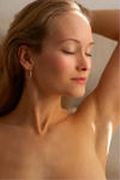|
|
Learn skin and help your skin
|
|

What is our skin?Skin has pigmentation, provided by melanocytes, which absorbs some of the potentially dangerous radiation in sunlight. It also contains DNA repair enzymes which reverse UV damage, and people who lack the genes for these enzymes suffer high rates of skin cancer. One form predominantly produced by UV light, malignant melanoma, is particularly invasive, causing it to spread quickly, and can often be deadly. Human skin pigmentation varies among populations in a striking manner. This has sometimes led to the classification of people on the basis of skin color. See the article on human skin color. Mammalian skin often contains hairs, which in sufficient density is called fur. The hair mainly serves to augment the insulation the skin provides, but can also serve as a secondary sexual characteristic or as camouflage. On some animals the skin is very hard and thick, and can be processed to create leather. Reptiles and fish have hard protective scales on their skin for protection, and birds have hard feathers, all made of tough β-keratins. Amphibian skin is not a strong barrier to passage of chemicals. A frog sitting in an anesthetic solution will quickly go to sleep. Blood capillaries are found beneath the epidermis, and are linked to an arteriole and a venule. Arterial shunt vessels may bypass the network in ears, the nose and fingertips. The dermis lies below the epidermis and contains a number of structures including blood vessels, nerves, hair follicles, smooth muscle, glands and lymphatic tissue. It consists of loose connective tissue otherwise called areolar connective tissue - collagen, elastin and reticular fibres are present. Erector muscles, attached between the hair papilla and epidermis, can contract, resulting in the hair fibre pulled upright and consequentially goose bumps. The hypodermis is not part of the skin, and lies below the dermis. Its purpose is to attach the skin to underlying bone and muscle as well as supplying it with blood vessels and nerves. It consists of loose connective tissue and elastin. The main cell types are fibroblasts, macrophages and adipocytes (the hypodermis contains 50% of body fat). Fat serves as padding and insulation for the body. The skin must be regularly cleaned. Unless enough care is taken it will become cracked or inflamed. Unclean skin favors the development of pathogenic organisms. Skin care scienceThe first step to taking care of your skin is preventing damage. Sun, wind, pollutants, and simply aging can degrade the condition of your skin. Common complaints include dry and itchy skin, wrinkles, sagging, color changes, and age spots. There are steps that you can take to keep you skin looking and feeling its best. Exercise, rest, and good nutrition lay the foundation for beautiful, healthy skin, inside and out. A proper diet is not only good for your overall health, it also helps to ensure that your skin will receive all of the vitamins, minerals, and nutrients that it needs to maintain and repair cells. Drinking purified water is another good way to keep your skin healthy. Water helps to hydrate the skin and move waste and nutrients through the system. It is very effective mixing a teaspoon or capful of Organic Apple Cider Vinegar in with your water. Do not drink Tap Water. The most important way to care for your skin is to protect it from the damaging rays of the sun. Ultraviolet radiation damages the skin and can lead to wrinkles, premature aging, age spots, and cancer. Take extra precautions to make sure your skin is not exposed to the sun's rays. Use a natural sunscreen, or a moisturizer that contains sunscreen (at least SPF 15) everyday. Your skin does need some sunlight 10-15 minutes of direct exposure daily. Dry skin is very common, especially with age. Older skin has fewer sweat and oil glands than younger skin. Dry skin may be caused by frequent baths, certain cosmetics or medications. But whatever the cause, there are ways to alleviate the itchiness associated with it. Avoid using harsh soaps when bathing, and if possible, cut back on the number of baths or showers each week. A sponge bath with warm water may help to clean and revive skin without stripping the skin of its valuable moisturizers. Acne, pimples, sunspots, age spots, wrinkles and other blemishes are skin conditions that plague people the world over. The global beauty industry already makes billions of dollars every year as women everywhere embark on quests to preserve (or achieve) a youthful, glowing appearance. Responding to this need, dermatologists, and other specialists continue to look for the best and safest possible treatments and formulations to combat skin ailments, the most common of which is acne. Why is it that practically everyone in the middle class to the upper levels of demographics in any country are worried about getting wrinkles? Maybe it is the fear of getting old or looking old, or the wanting to look socially acceptable, or just plain vanity. We all have our own reasons. But whatever it is, everyone is united in wanting to solve this age old problem. However, in the first place, do we even have any idea about what actually causes these dreaded wrinkles? It's highly probable that we don't. The most important factor in finding a solution to any problem is finding out the root cause of it. Over the years, beauty experts and skin doctors have come up with a vast array products to treat and minimize wrinkles. Anti-wrinkle creams and ointments help reduce the appearance of wrinkles and prevent new ones from forming. These wrinkle ointments and anti-aging creams help a lot in restoring the skin's firmness and elasticity. In addition, these products contain anti-oxidants and retinol that not only aids in reducing wrinkles and fine lines on the skin, but also stimulates collagen production. For people seeking solutions to severe damage that has already been done to the skin, there are a number of treatments available ranging from chemical peels and dermabrasion to the latest and technologically advanced, computerized laser resurfacing. However, many people looking for skin repair are hesitant to try chemical or laser peels due to the painful procedure and long recuperation period they have to undergo. The results of these procedures however, are fantastic. One less painful procedure is the particle skin resurfacing procedure. The process is removes the outer layer of skin in a highly controlled manner. Because of its preciseness, it is practically painless. By repeating this procedure a number of times, the younger skin moves to the surface, thus promoting visible changes in the skin's texture, color and appearance. The benefits of this skin resurfacing procedure are that it causes very little pain or discomfort, no recuperative period is needed, there is minimal risk, it can be used for all skin types, and no anesthesia is required. The important thing to remember when seeking out treatment for your wrinkles is to know first how your body can possibly react to the treatment. Get in touch with a skin doctor for things that you are not sure of, but are contemplating on trying out. There are a lot of skin care products in the market today. Unlike before when a normal bar of soap was used for skin cleansing, cosmetic companies are now producing a wide variety of skin care treatments that can address various skin concerns. However, there are cases when treatments need to be more aggressive, especially for those who have aging or blemished skin. Most, if not all, of the over-the-counter products are topical in nature, meaning it only affects the epidermis or the outer layer of the skin. Aging or blemished skin needs to be treated down to the root of the problem to see definite changes.
Terms interpretingEpidermis Hypodermis Pimples Ultraviolet radiation Find yourself a new love
|
|
Information in this document about Skin care named Learn skin and help your skin is for End User's use only and may not be sold, redistributed or otherwise used for commercial purposes. The information is an educational aid only. It is not intended as medical advice for individual conditions or treatments of Skin care. Additionally, the manufacture and distribution of herbal substances are not regulated now in the United States, and no quality standards currently exist like brand name medicine and generic medicine. Talk about Skin care to your doctor, nurse or pharmacist before following any medical regimen to see if it is safe and effective for you. © Copyright 2007 Beauty Organization of Ireland, Skin care department. |
